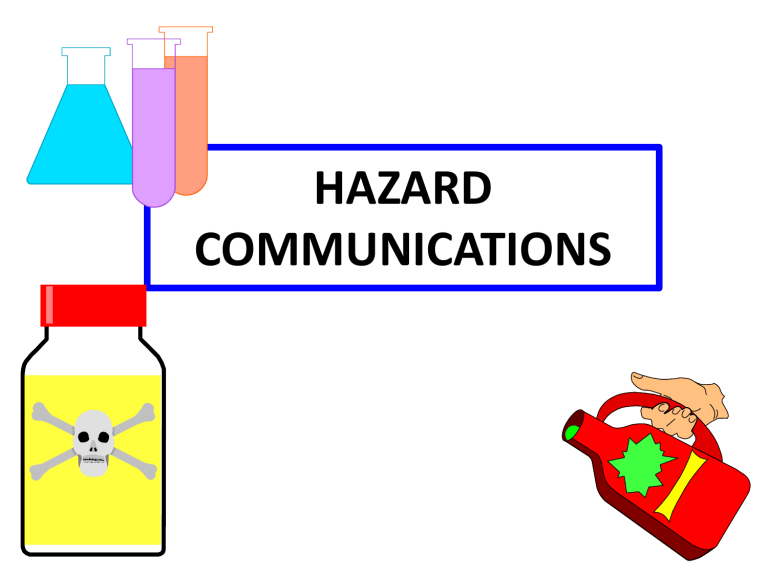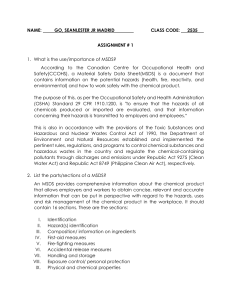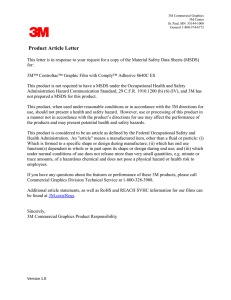
HAZARD COMMUNICATIONS HAZARD COMMUNICATIONS What is Hazard Communication or Hazcom? Answers will vary but should include: • Employees have a right to know hazards and identities of chemicals they will be exposed to; • should know what protective measures are available What is the Hazcom • Designed to reduce incidence of chemically-related occupational illnesses and injuries; • Called “worker right to know” ; • Ensures that all chemical hazards in workplace are identified and explained • Emphasis on communication • This covers both physical hazards (flammability) and health hazards (irritation, lung damage, etc.) • Chemical manufacturers and importers must evaluate hazards of their chemicals and prepare labels and Material Safety Data Sheets or MSDS. • A Performance standard. This means can adapt the standard to our specific needs and our work environment. Basic Requirements MSDS Labeling Written Program Inventory Training Basic Requirements 4 major requirements of the program: • Inventory of the workplace • Material Safety Data Sheets (MSDS) • Labeling and other forms of warning • Employee training and information HOW TO CONDUCT A WORKPLACE INVENTORY • • • • • • • Identify Materials By Department. Note Operations Performed Dept. By Dept. Look at Labeling. Identify Material by Processes. Look at materials use by other Contractors. Look at materials on site and in storage. Look in all areas. HOW TO CONDUCT A WORKPLACE INVENTORY • Is there anything that should be included that we’ve forgotten? • Review purchases, check warehouse, identify any by-products such as fumes from welding operations, janitorial supplies, piping within the facility, certain operations performed on an irregular basis but may involve hazardous substances such as confined space entry. • Key Point-must be a comprehensive list and must take a comprehensive approach and remember, the standard covers more than just chemicals in containers. The standard covers chemicals in all physical forms such as solids, liquids, gases, vapors, fumes, and mists whether they are contained or not. HAZARDOUS MATERIAL INVENTORY DEPARTMENT PRODUCT NAME HAZARDOUS MATERIALS/ BY PRODUCT MANUFACTURER LABELS NEEDED CURRENT MSDS MAX. QUANTITY ON HAND HAZARDOUS MATERIAL INVENTORY • This is an example of a form that can be used. You can probably come up with some suggestions for other columns of information as well. • Identify as many hazardous chemicals in your work area as you can. • Once inventory is complete, you are ready to move on to the next major element of the program, Material Safety Data Sheets or MSDS Material Safety Data Sheets (MSDS) • • • • Purpose What Information they provide Readily accessible/complete/retain Someone responsible Material Safety Data Sheets (MSDS) • • An MSDS is a technical bulletin whose purpose is to provide detailed information on each hazardous chemical in the workplace.Chemical manufacturers and importers are required to obtain or develop an MSDS for each hazardous chemical they produce or import. Distributors are responsible for ensuring that their customers get MSDS and employers must have an MSDS for each hazardous chemical that they use. Remember, all concerned has the “right to know” . If you notice an MSDS with blank spaces, please notify the responsible person or your supervisor and they will see that a complete MSDS is obtained. There is no specified format for an MSDS but they must be in English and at a minimum they must contain: (refer to your MSDS or sample provided) identity (chemical or common name) used on container label, chemical and common name of all ingredients having known health hazards in concentrations greater than 1% and for known carcinogens at 0.1% or more, physical and chemical characteristics of hazardous components, physical and health hazards including signs and symptoms, primary routes of entry, any known exposure limits, is it a potential carcinogen, precautions for safe handling and use, control measures, emergency first aid procedures, date of preparation, and name, address, phone number of company or responsible person distributing the MSDS. Also, the MSDS must be readily accessible-during workshifts, in the immediate work area, and a responsible-designated person to keep MSDS current, correct, and available. Labeling • • • • • Purpose What information is required Accessible/Legible/in English Types; Mfg.’s, HMIS, NFPA Someone responsible Zip Cleaner Labeling • • • • • • All in-plant containers of hazardous chemicals must be labeled All products shipped by manufacturers must include: identity of material appropriate hazard warnings name and address of the producer or other responsible party All in-plant containers should include: identity of material appropriate hazard warnings Must be in English but other languages may be supplied as well Responsible person to ensure that all labels are in use, legible, and prominently displayed If possible, have some examples of your in-house containers that are properly labeled. Make the point that these container labels are only to serve as an immediate warning and are not substitutes for MSDS that must be available and accessible as mentioned earlier. Manufacturers Label Mfg.’s Name/Address Product Name Physical Warnings Health Hazard Warnings Including Target Organs Zip Cleaner XYZ Company PO Box 1 Anytown, OH Flammable, Avoid Prolong Breathing In House Label Product Name Physical Hazards Health Hazard Warnings Including Target Organs Zip Cleaner Flammable, Avoid prolonged breathing. Chemical Name Health Hazard Fire Hazard Flash Points 4-Deadly (red) 3-Extremely Hazardous 2-Hazardous 4-Below 73 F 3-Below 100 F (blue) 1-Slightly Hazardous 2-Below 200 F 0-Normal material 1-Above 200 F 0-Will not burn Specific Hazard Reactivity Oxidizer OXY 4-May detonate Acid ACID Alkali ALK 3-Shock and heat may detonate Corrosive COR Use NO WATER W Radiation Hazard (yellow) (white) 2-Violent chemical change NFPA Label 1-Unstable if heated 0-Stable HMIS LABEL Health (blue) Flammability (red) Reactivity (yellow) Personal Protective Equipment (white) Chemical Name:______________________________ HMIS LABEL • Hazardous Materials Identification System (HMIS) labels (briefly review areas on the label). • Like the MSDS, to ensure that labeling is accomplished properly, there should be someone designated as being responsible for ensuring that all in-plant containers are labeled. • Someone should also be responsible for ensuring that any shipped containers are properly labeled. • Have copies of your Hazcom program that talks about labeling. Employee Training • General Training • Specific Training General Training • Hazard Communication Knowledge • Employer’s Written Program • Location/Availability Of Written Program & MSDS • How to read labels & MSDS’s Specific Training • • • • • • • Characteristics Health & Safety Hazards Work practices or SOPs Emergency action plans Personal Protective Equipment (PPE) Non-routine tasks Industrial Hygiene monitoring results Written Program • Must be developed, implemented & maintained • A blueprint for how the requirements will be met • Readily accessible Miscellaneous • Non-Routine Tasks • Piping Systems • Contractors/ Multi-Employer Worksites Miscellaneous • Finally, in addition to the four major elements of a hazcom program discussed above, there are some miscellaneous items that also need to be addressed in a written program. • Non-routine tasks are tasks that are not performed on an everyday or a regular basis such as cleaning out vats or changing filters (give examples of your non-routine tasks if applicable) • Piping systems would identify how unlabeled piping is to be dealt with • Contractors and multi-employer worksites would spell out how information will be exchanged on hazardous substances. It is also important to note that your employees may need to be trained on any hazards that contractors might bring to your site as well. Summary • What is Hazcom? • Why was the Hazcom Standard implemented? • What are the 4 major elements of our written Hazcom program? • Why is a workplace inventory important? • What is the purpose of an MSDS? Thanks and Communicate the Information


